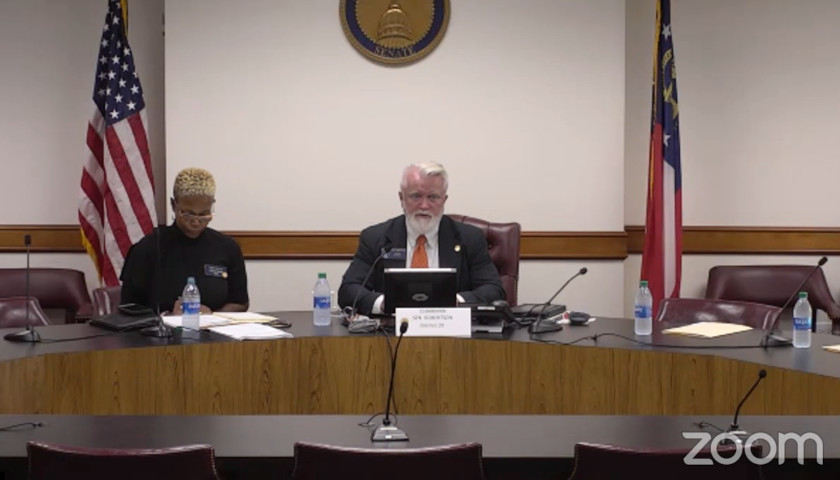A committee established this year to examine retirement security for Georgians focused on public servants’ retirement needs in a hearing Thursday, particularly those of law-enforcement officers strained by heightened crime and a hostile media.
Members of the Senate Retirement Security for Georgians Study Committee examined pension reform—specifically the potential shifting from the current 401(k) system to an entirely defined-benefit plan for state law-enforcers—to attract and retain more personnel.
At the hearing, Major J. M. Lamb, chief of staff of the Georgia Department of Public Safety (DPS) advocated for a 100-percent defined-benefit system that guarantees lifetime annuity to enhance recruitment and retention. (The state’s current plan, instituted for new hires in 2009, does contain a small defined-benefit component.) Lamb also advocated for higher officer pay.
“It buys loyalty over time,” he said.
Since 401(k) plans are portable, Lamb explained, a DPS officer considering leaving for employment elsewhere has extra incentive to do so. Such plans also do not offer a predictable pay scale.
DPS now employs approximately 1,500 people statewide. Of those, 745 are state troopers and 223 are motor-carrier officers, totaling the lowest number of sworn officers the state has retained in Lamb’s 25 years in law-enforcement. His agency hopes to raise the number of troopers to at least 1,000, slightly higher than the number usually reached in years past.
Lamb attributed the present lack of adequate retention and recruitment to the demonization of the police by the press which “emboldens the criminal element of society.”
According to a recent FBI report, homicides increased by almost 30 percent nationwide from 2019 to 2020, a larger year-to-year-jump than any since 1960. In Georgia, killings spiked 55 percent during that time.
Beginning in late spring 2020, in the aftermath of George Floyd’s death in police custody in Minneapolis, Minnesota, leftists across the nation sounded calls to “defund the police.”
“As most are aware, the past 18 months have been difficult for law enforcement,” Lamb said. “From civil unrest to a nationwide pandemic and a violent-crime wave, law enforcement has stood on the front lines and done whatever has been asked of them. Unfortunately, many in society have demonized the police as being the cause of all of society’s woes. As expected, this has taken a toll on law enforcement and it is reflected in our recruitment and our retention numbers.”
DPS has had an average 22-percent turnover rate over the last three years as well as a 60-percent fall in applications during that period, Lamb said.
Over the years, bringing in new officers has been the main focus of DPS’s personnel strategy, Lamb observed, but lately “retention has become as much of an issue as recruitment.”
He noted the process of becoming a state officer is itself arduous. The department subjects all recruits to a physical-fitness examination, a polygraph test, a medical exam, mental-health analysis, and a board interview, all before a psychically and physically strenuous 34-week officer-schooling period begins. Many candidates don’t make it through even that pre-training process. All told, an officer will spend about a year on these anticipatory activities before officially working, at a cost of about $90,000 to the state, not including vehicle costs.
In 2020 alone, the department lost 87 troopers as a result of either resignation, retirement or firing. Those officer’s training costs alone were at least $7.8 million.
DPS has taken some steps already to address recruitment deficiency. Among other measures, the agency is implementing an accelerated (13-week) trooper academy scheduled to begin in January, allowing tattooed individuals to become DPS members and increasing the starting salary for officers in training from approximately $37,000 to over $47,000. But Lamb said even these measures have proven insufficient when it comes to amassing the personnel the state needs.
While members of the study committee did not explicitly announce an intention to shift from the current defined-contribution paradigm toward a defined-benefit offering, Chair Randy Robertson (R-Cataula) observed such plans’ attractiveness to employees. Robertson is himself a retired law-enforcement professional who served the Muscogee County Sheriff’s Office.
“Defined-benefit plans are great,” he said. “They’re expensive but they are good.”
The hefty cost of such plans, when offered to high numbers of public employees, is what inspired a few states like Georgia to transition away from them generally. While most states still provide them to public workers, they have received scrutiny for contributing significantly to debt in many states.
The free-market Georgia Public Policy Foundation has credited the adoption of a partial 401(k) system with alleviating costs to taxpayers and putting the Peach State in a better position than most others regarding pension debt, albeit a position with “a great need for improvement.”
According to figures from the Georgia Employees Retirement System and the Georgia Teachers Retirement System, combined unfunded pension liabilities totaled about $26 billion as of 2019.
– – –
Bradley Vasoli is a reporter at The Georgia Star News and The Star News Network. Follow Brad on Twitter at @BVasoli. Email tips to [email protected].





